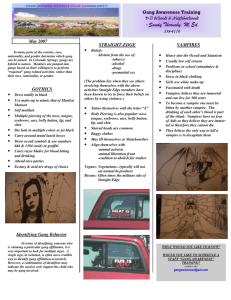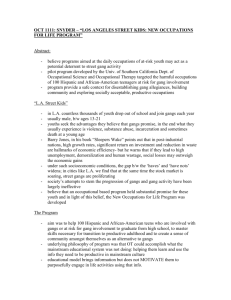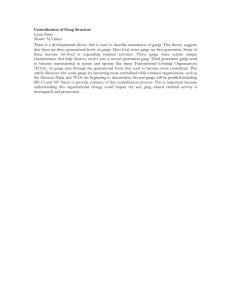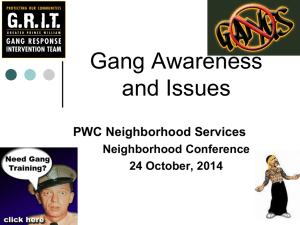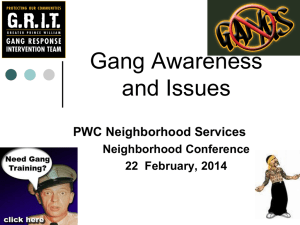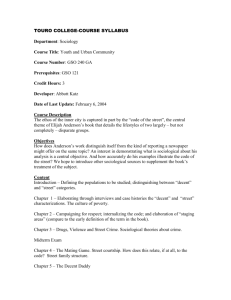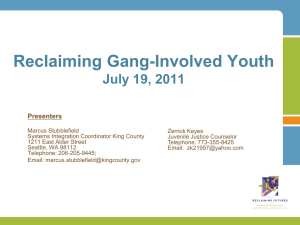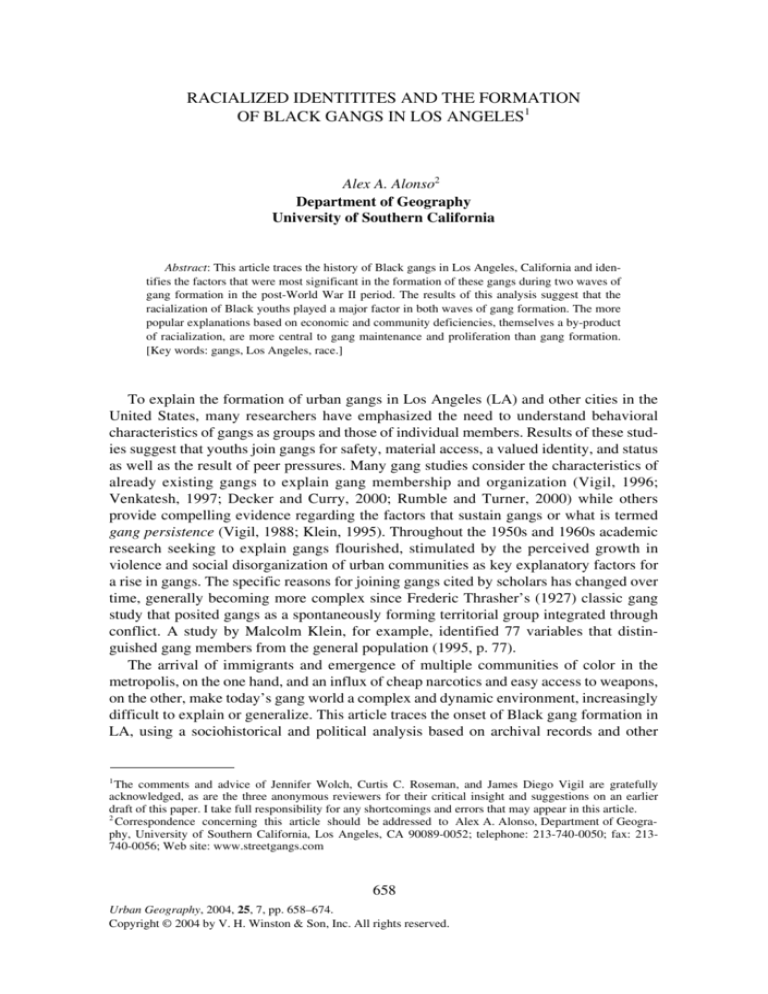
RACIALIZED IDENTITITES AND THE FORMATION
OF BLACK GANGS IN LOS ANGELES1
Alex A. Alonso2
Department of Geography
University of Southern California
Abstract: This article traces the history of Black gangs in Los Angeles, California and identifies the factors that were most significant in the formation of these gangs during two waves of
gang formation in the post-World War II period. The results of this analysis suggest that the
racialization of Black youths played a major factor in both waves of gang formation. The more
popular explanations based on economic and community deficiencies, themselves a by-product
of racialization, are more central to gang maintenance and proliferation than gang formation.
[Key words: gangs, Los Angeles, race.]
To explain the formation of urban gangs in Los Angeles (LA) and other cities in the
United States, many researchers have emphasized the need to understand behavioral
characteristics of gangs as groups and those of individual members. Results of these studies suggest that youths join gangs for safety, material access, a valued identity, and status
as well as the result of peer pressures. Many gang studies consider the characteristics of
already existing gangs to explain gang membership and organization (Vigil, 1996;
Venkatesh, 1997; Decker and Curry, 2000; Rumble and Turner, 2000) while others
provide compelling evidence regarding the factors that sustain gangs or what is termed
gang persistence (Vigil, 1988; Klein, 1995). Throughout the 1950s and 1960s academic
research seeking to explain gangs flourished, stimulated by the perceived growth in
violence and social disorganization of urban communities as key explanatory factors for
a rise in gangs. The specific reasons for joining gangs cited by scholars has changed over
time, generally becoming more complex since Frederic Thrasher’s (1927) classic gang
study that posited gangs as a spontaneously forming territorial group integrated through
conflict. A study by Malcolm Klein, for example, identified 77 variables that distinguished gang members from the general population (1995, p. 77).
The arrival of immigrants and emergence of multiple communities of color in the
metropolis, on the one hand, and an influx of cheap narcotics and easy access to weapons,
on the other, make today’s gang world a complex and dynamic environment, increasingly
difficult to explain or generalize. This article traces the onset of Black gang formation in
LA, using a sociohistorical and political analysis based on archival records and other
1
The comments and advice of Jennifer Wolch, Curtis C. Roseman, and James Diego Vigil are gratefully
acknowledged, as are the three anonymous reviewers for their critical insight and suggestions on an earlier
draft of this paper. I take full responsibility for any shortcomings and errors that may appear in this article.
2
Correspondence concerning this article should be addressed to Alex A. Alonso, Department of Geography, University of Southern California, Los Angeles, CA 90089-0052; telephone: 213-740-0050; fax: 213740-0056; Web site: www.streetgangs.com
658
Urban Geography, 2004, 25, 7, pp. 658–674.
Copyright © 2004 by V. H. Winston & Son, Inc. All rights reserved.
RACIALIZED IDENTITIES IN LOS ANGELES
659
published reports to explain gang formation. Most such studies do not necessarily shed
light on questions of gang formation, namely, how and why do gangs form in specific
communities and what spatial processes foster such formation? This analysis makes clear
that at the root of gang formation are certain precipitating factors and suggests why specific geographical locales, as opposed to others, have been vulnerable to gang formation.
By focusing on gang formation I attempt to show how the racialization of identities
played a major role in the gang formation process during two different post-World War
II periods in LA. I argue that racialized identities and structural constraints contributed
to early formation processes of traditional gangs.3 Several classic and contemporary
theories on gangs have shown the spatial linkages between immigrant and minority
communities on the one hand, and gangs on the other, but existing theories have yet to
make the connections between institutional practices, blatant societal prejudice, and the
racialization of minorities as major factors toward gang formation. Generally, the literature fails to connect gang formation directly to racial inequality (Spergel, 1995, p. 161–
162) but this paper will reveal how the racialization of Blacks played a critical role in the
early formation of LA street gangs.
Two periods of gang formation in South LA are addressed here: the late 1940s and
early 1970s. This paper links early gang formation in LA among Black youths in the
1940s to processes of residential segregation, police brutality and racially motivated
violence and the aftermath of the civil rights period of the 1960s that led to the assassinations of many national and local LA activists that created a breeding ground for gang
formation in the early 1970s. Although factors such as economic restructuring, deindustrialization, population shifts and poverty explain recent gang phenomena and have
contributed to understanding gang maintenance and proliferation (Padilla, 1992; Shelden
et al., 2001), I argue that these factors played a minimal role in early gang formation
processes. Rather racial intimidation, school and residential segregation, extreme marginalization and racial exclusion from mainstream LA all played more significant roles in
early gang formation among Blacks.
The following section of this paper briefly sketches the most widely recognized gang
theories to date. Many of these explanations are useful as a means of understanding gang
maintenance and proliferation, but do not provide enough explanation regarding gang
formation in a place where gangs did not previously exist. Then, I provide a history of
LA’s Black gangs based on archival information and published reports. Lastly, I suggest
a conceptual model of gang formation in LA.
THEORIES OF GANG FORMATION
Early literature from the turn of the 20th century emphasized a biological basis for the
development of gangs (Puffer, 1912). By the 1920s, followers of the Chicago School
relied on cultural ecological models (Thrasher, 1927), while some more recent analyses
using the underclass theory stress the urban economic as well as social bases for gang
3
This overview is only relevant to understanding the formation of the older traditional gangs in Los Angeles.
These processes do not relate to the formation of emergent and newer gangs that formed in the 1980s and
1990s. For a descriptive explanation of traditional and other types of gangs, see Klein and Maxson, 1996.
660
ALEX A. ALONSO
activity (Hagedorn, 1988; Klein, 1995). One of the shortcomings shared by many of these
approaches is how race, immigrant status and social structure shape the place where
gangs form. Most gang formation theory discusses at some length how communities of
racial minorities are affected without much discussion about the racialization processes
involved. Race is usually reduced to poverty, culture and behavior in explanations of
higher rates of gang activity in minority neighborhoods.
NATURE AS CULTURE AND EVOLUTIONARY PERSPECTIVES
John Puffer’s analysis of gangs in the Boston area found that they engaged in outdoor
activities, but several commonly embraced what he called shadier activities—smoking,
drinking, and fighting (1912, p. 40). Puffer’s gangs were “play groups” that spontaneously formed due to what he termed the “gang-forming instinct” present only in boys,
acquired from ancestral relatives and prehistoric peoples that had ancestral ties (p. 25).
Frederic Thrasher published an empirical sociological gang study 15 years later that
was rooted in the Chicago School tradition that used a natural history model to explain
gang formation. Rather than using Puffer’s gang instinct approach, Thrasher articulated
an ecological theory, suggesting that gangs developed from specific conditions and
experiences (1927, p. 44).
He argued that gang formation was a spatial and social process most prevalent in
places that he characterized as “geographically and socially interstitial” places of the city
(Thrasher, 1927, p. 22), areas of social disorganization that included deteriorating homes,
demographic change, and high immigrant populations. Because of isolation, competition,
and conflict occurring in these places, they had been “naturally selected” for gang formation. Gangs formed as the result of the interaction between youths and the physical and
social environment.
Also working in the Chicago School tradition, Clifford Shaw and Henry McKay
examined gangs in the early 1930s in the “natural” urban areas of Chicago, as defined by
the concentric zone and ecological models.4 Pioneers of cultural deviance theory, they
suggested that gangs formed from “learned behaviors” that emerged by means of weak
societal controls in socially disorganized communities. These neighborhoods were characterized by extreme poverty and isolation, but more importantly an inability to inculcate
common values of health, life, law, education and family to younger residents. The level
of disorganization depended on economic conditions, land-use change, population shifts
(especially immigration), and the share of Blacks and immigrants within the community
(Empey, 1982, p. 191; Kornhauser, 1978, p. 63). These conditions encouraged the formation of gangs, whose traditions were transmitted to new generations of youths, continuing
the cycle and leading to the persistence of gangs as an element in social structure
(Kornhouser, 1978, p. 64).
4
The 1942 text by Clifford Shaw and Henry McKay titled Juvenile Delinquency and Urban Areas: A Study of
Rates of Delinquency in Relation to Differential Characteristics of Local Communities in American Cities did
not include gangs, but all of the work regarding social disorganization, community control, and cultural transmission present in the 1942 study is evident in the work from 1931 on gangs. For a detailed descriptive analysis
of the two publications, see Knox, 1998.
RACIALIZED IDENTITIES IN LOS ANGELES
661
LOWER-CLASS STATUS AND CULTURE
Albert Cohen (1955) outlined a social strain model of gang etiology that challenged
the social disorganization approach. According to Cohen, communities classified as
socially disorganized actually consisted of a vast network of informal institutions and
associations that exhibited defects in organization (p. 32). Moreover, he questioned
the root of gang formation, suggesting instead that the emergence of a “delinquent subculture” was behind the creation of gangs, utilizing a psychogenic approach to explain
delinquency: all human action is an ongoing effort to problem-solve (p. 50).
Working class youths had status problems when operating within a middle class social
system of values. Because the middle class evaluated the working class in a discriminatory way, marginalization was the source for strain and adjustment problems for working
class youth. This strain engendered the development of a distinct subculture, which
helped working class boys and young men to construct their own solutions in response to
the failure of institutionalized approaches, such as formal schooling (p. 59).
In contrast, Walter Miller stated that gangs did not form as a reaction to achieve
middle class values, but from “focal concerns” of lower class culture and everyday life
(1958, p. 6). A specific cultural system operating in the lower class community influenced certain behavioral patterns that contributed to gang formation independent from
(and not in reaction against) middle class values. These focal concerns included toughness, trouble, smartness, excitement, fate, and autonomy (p. 7). The gang was a product
of the broken family and lower class culture, stressing reputation, status and masculinity,
that were disconnected and unaffected by the middle class measuring rod.
UNDERCLASS THEORY AND GANG FORMATION
William Julius Wilson (1987) linked the existence of an urban “underclass” to economic dislocations, deindustrialization, lower class values (similar to Miller’s analysis of
the gang culture), prevalence of female-headed families (p. 26), joblessness and high incidences of criminal behavior and high rates of gang violence (1996, p. 59). According to
Wilson, an isolated underclass population formed as the result of the out-migration of the
middle class from the inner city, leaving a socially unstable and politically powerless
community spiraling into persistent poverty.
Wilson’s underclass model has been challenged for being disconnected to historical
events, failing to explain the disproportionate incidence of pathology in communities of
color, and lacking empirically grounding (Omi and Winant, 1994; Steinberg, 1995).
Moreover, according to Hughes (1989), the underclass phenomenon is rooted in geographical/spatial categories such as ghetto, community, mismatch, suburbanization and
neighborhood—categories left unproblematized in Wilson’s analysis. Additionally, the
underclass theory has not been able to explain fluctuations in gang crime as they rise and
drop (Spergel, 1992, p. 128). Nevertheless, Wilson’s ideas became influential and not
surprisingly figured into contemporary gang formation theory.
For example, John Hagedorn (1988) drew on Wilson’s underclass thesis to explain
Black gang activity in Milwaukee during the 1980s, emphasizing economic restructuring,
poverty concentration, and concomitant diminished sense of community stimulating suburbanization of more middle class Blacks, leaving older neighborhoods prone to gang
662
ALEX A. ALONSO
formation. Similarly, Malcolm Klein (1995) used underclass theory to explain gang formation as well as aspects of gang persistence. Gang persistence, according to Klein, was
linked to deindustrialization, economic changes in the inner city, the failure of the education system, suburbanization of middle class Blacks, and residential segregation (p. 194).
A second category of variables related to gang maintenance was linked to psychological
aspects of gangs such as status, identity, and belonging (p. 198). Klein offered an additional class of indicators to explain gang formation linked to structural and community
features such as number of minority youth and absence of jobs. In short, Klein saw a
burgeoning underclass community causing gang “onset” variables to emerge that were in
turn connected to the psychological features that perpetuated gang traditions. As the
urban underclass population grew so would gangs.
MULTIPLE MARGINALITY
While accepting some aspects of earlier theories, in his study of Latino gangs in LA,
James Diego Vigil (1988) emphasized that the interaction of several pressures together
determined the life chances of barrio youths in his multiple marginality thesis. Thus there
was no single cause of gang formation, but rather multidimensional pathways that differed for each individual. Vigil’s multiple marginality approach rested on a synthesis of
variables including mother-centered homes, lack of male adult guidance, and low-income
status that led youth toward poor school performance, increased contact with law enforcement, and the beginnings of an aggressive lifestyle. In addition, Vigil emphasized the
need for an historical consideration of barrio life (p. 172) that focused on the social
history and context of settlement and residential patterns, low immigrant wages, poor
community planning, and racial discrimination, which were all tied to gang formation. A
combination of these processes led to an entrenched low-income population living in
spatially isolated communities in inferior housing (p. 65).
SUMMARY AND CRITIQUE
What is most striking about the corpus of gang formation research is the limited discussion of how race and structure have worked together to create communities that have
produced gangs. This apparent omission leads to some major shortcomings in both contemporary and traditional gang formation theory. The slum conditions, extreme poverty,
and deteriorating homes that Thrasher observed in Chicago were never directly linked to
racial status, residential segregation, or any form of racial discrimination that may have
contributed to and fostered a climate conducive to gang formation. Additionally Shaw
and McKay made no mention of the structural constraints and prejudices in their theoretical construction. Albert Cohen’s social strain model was more associated with class
status than race and Walter Miller’s lower-culture thesis made no direct link to race.
Klein’s model provides a thorough explanation of gang sustenance and proliferation
but early formation processes were not rigorously explored. His mention of minority
segregation (p. 199) is only marginally linked to race. Gangs existed in many urban communities long before the deindustrialization in the mid-1970 and 1980s and Black middle
class suburbanization occurred.
RACIALIZED IDENTITIES IN LOS ANGELES
663
To fully understand the dynamics of these gangs, we must view them from an historical
perspective that illuminates the roles of race, place and social structure in early gang formation. Vigil’s multiple marginality theory explains how gangs emerged in the barrios of LA
by emphasizing how the historical circumstances of residential segregation, community isolation, low socioeconomic status and racism were contributing factors in early gang formation. Although Vigil’s thesis integrates the underclass argument, he does not gloss over the
effects of race but he does not provide a specific example of a gang forming.
BLACK GANG FORMATION IN LOS ANGELES
What about the Black gangs that emerged in LA in the postwar period? The academic
literature is largely silent on this question, despite the extensive publicity accorded to
LA’s Black gangs. In what follows, I provide an account of their formation, giving
special consideration to the historical record, archival research and a series of in-depth
interviews. In addition, I draw on earlier research (Alonso, 1999) that mapped the historical geography of Black street gang territories in LA, using law enforcement reports,
extensive ethnographic analysis, and a territorial delimitation technique based on a gang
graffiti analysis (see Appendix for methodological details).
This narrative draws on an extensive body of literature, including newspaper articles,
unpublished papers, doctoral dissertations, scholarly articles and books, and a variety of
law enforcement documents. In addition, this story incorporates information from
in-depth interviews with key figures that participated in gangs during the period under
scrutiny. Many of these interviews were conducted during annual reunion picnics in Los
Angeles, where several hundred former gang members, going back to the late 1940s,
would congregate. The open-ended interviews focused on gang history, and life in the
community. More than 25 individuals were interviewed on multiple occasions (see
Alonso, 1999, pp. 71–96).
This historically grounded and place-based approach allows us to see how Black
migration into LA, school and residential segregation, political struggle, and other structural factors contributing to the profound ghettoization of South LA, laid the foundation
for the city’s Black gangs. It is only within this context of intense racialization, marginalization, a deeply rooted racial social order and overt acts of racial violence that we can
understand what triggered successive waves of Black gang formation in LA.
Gang formation among Blacks occurred during two periods, following WW II in the
late 1940s and during the early 1970s. There was a lull of Black gang activity from 1965,
after the Watts insurrection, up until the early 1970s when the contemporary Black gangs
formed. This marked the beginning of the second phase of gang formation, which saw the
rise of LA’s newest gangs that continued to grow during the 1970s, reaching epidemic
proportions in the late 1980s and early 1990s.
POST-WORLD-WAR II TO 1965
The first major period of Black gang formation in LA began in the late 1940s after
thousands of Blacks migrated from the South to fill WW II jobs. Restrictive covenants,
legalized in the 1920s, maintained social and racial homogeneity of neighborhoods by
denying non-Whites access to property ownership (Bunch, 1990, p. 114). By the 1940s
664
ALEX A. ALONSO
such exclusionary practices had rendered much of LA off-limits to most minorities
(Bond, 1936; Davis, 1990, pp. 161, 273; Dymski and Veitch, 1996, p. 40). Chronic overcrowding was taking a toll, and housing congestion became a serious problem as Blacks
were forced to live in substandard housing confined by specific boundaries (Collins,
1980, p. 26; Bunch, 1990, p. 117). By the 1940s, Black residents continually challenged
restrictive covenants in court, in an effort to leave their overcrowded Central Avenue
neighborhood. These attempts resulted in violent clashes between Whites and Blacks
(Collins, 1980, p. 30).
Throughout the 1940s, White resentment and racial paranoia grew as the Black population did, and especially as Blacks attempted to integrate into public schools while challenging the housing discrimination laws that prevented them from purchasing homes
outside the original Black settlement area. In nearby areas of Huntington Park, Bell and
South Gate some White Angelenos maliciously reacted against the growing Black population. Here White teenagers formed street clubs during the 1940s to terrorize Black
youth. One of the most infamous was the Spook Hunters, a group of White teenagers that
often attacked Black youths in the neighboring communities (Alonso, 1999, p. 74).
Blacks seen outside of their neighborhoods were often physically attacked (Horne, 1995,
p. 190). These White street clubs focused their efforts at spatially confining Blacks in
“their” neighborhoods, fighting school integration and protecting racial purity in the community (Bunch, 1990, p. 117). The Spook Hunters would work toward these goals by
instigating fights and intimidating Black youths.
This type of racial confrontation was not uncommon, nor was it restricted to LA.
Thrasher (1927, p. 37), for example, identified a White gang in Chicago during the 1920s
called the Dirty Dozens that often attacked Black youths with knives, blackjacks, and
revolvers because of racial differences. In Steven Gregory’s historical analysis of Black
migration into Queens, New York he found that intensified racial segregation transformed the neighborhood of Corona, Queens and that a rigid color line developed in the
early 1950s. The Dukes, a White gang, were intimidating Black residents and exacerbating racial conflict (Gregory, 1998, p. 63). It was also found that one of the major factors
contributing to gang formation in Chicago was the race riot of 1919 that ignited many
Black males to unite together to confront hostile White hoodlums who were terrorizing
the Black community (Spear, 1967, p. 201; Perkins, 1987, p. 40).
In LA, Raymond Wright, one of the founders of the Businessmen5 stated “you couldn’t
pass Alameda Blvd, because those White boys in South Gate would set you on fire”
(Alonso, 1999, p. 75). Fear of attack from Whites was widespread and this intimidation
led to the early formation of Black social street clubs aimed at protecting Black youths
against persistent White violence directed against the growing Black community. Again,
similar club formation patterns were seen in other cities. For example, Suttles observed
that Black gangs in Chicago acted as guardians and served a useful social function in the
community. He also observed an alliance between Blacks and Mexicans, in anticipation
of conflicts with local Whites (1968, pp. 135–136).
5
The Businessmen were one of the first Black clubs to form in Los Angeles during the late 1940s. They were
based in the Central Vernon area of Los Angeles and were also known as the Bossmen (Alonso, 1999, pp. 72–76).
RACIALIZED IDENTITIES IN LOS ANGELES
665
Fig. 1. Black gang territories in Los Angeles, 1960. See Appendix for methodology of map construction.
The first major Black gangs surfaced on the Eastside of LA near Jefferson High
School in the Central Avenue area, and began to spread south and westward (Fig. 1). As
Black clubs began to negotiate strategies to combat White intimidation and violence, the
effectiveness of White efforts to combat integration and residential segregation began to
fail. White Angelenos viewed the burgeoning minority population as a threat (Hahn,
1996, p. 79) while many Blacks viewed Black gang formation as a legitimate defense
against violence. Eventually White flight set in and Anglo residents took advantage of
new suburban developments, leaving South LA behind. This left the central district of LA
as a Black enclave that represented 71% of the inner-city population (Brunn et al., 1993,
p. 53) and by 1960, the three Black communities of Watts, Central Ave., and West
Adams, previously islands of Black residence, had consolidated into one large continuous
Black community with low, middle and upper class districts (Alonso, 1999, p. 77; Robinson, 2000, p. 158).
During the early 1960s conflict among Black clubs was growing as White residents
continued to move out. As White clubs began to fade from the scene, eventually the Black
clubs, which were first organized as protectors of the community, began to engage in
conflicts with other Black clubs. Black gang activity represented a significant proportion
of gang incidents (Los Angeles County Probation Department and Youth Studies Center,
1962, p. 1), and by 1960 club rivalry led to six murders (Los Angeles Police Department,
1961, p. 28) a figure considered extremely high at that time, making Black-on-Black
666
ALEX A. ALONSO
violence between the clubs a serious concern in LA. In 1965, however, after the Watts
Rebellion and under the leadership of several socially conscious organizations, most of
this rivalry and violence among Black gangs ended. Black youths became politically
mobilized and turned their attention toward the social problems that plagued their community. Gang members were successful in transforming several Black youths of South
LA into “revolutionary soldiers” against police brutality (Hilliard and Cole, 1993, p.
218). The Rebellion of 1965 was considered “the Last Great Rumble,” as members of
these groups dismissed old rivalries and supported each other against heightened police
brutality (Baker, 1988, p. 28; Davis, 1990, p. 297), thus Watts epitomized the emergence
of a movement to build institutions led by and entirely responsible to the [Black] community (Bullock, 1969, p. 69).
SOCIOPOLITICAL PERIOD, 1965–1970
In the aftermath of the rebellion, young people, including gang members began to
build political institutions to contest social injustices, specifically police brutality. Until
the decade’s end, Black political groups were organizing and during these years Black
street gang activity lessened. Reports that Black gang activity was on the decline began
to circulate (Klein, 1971, p. 22) and according to one Los Angeles Police Sergeant, during
the mid- and late-1960s, juvenile gang activity in Black neighborhoods was scarcely
visible to the public at large and of minimal concern to South-central residents (Cohen,
1972). The formation of new political and social movements, especially the Black
Panther Party (BPP) and the civil rights-oriented U.S. Organization,6 offered Black
youths vehicles for building self-esteem and self-affirmation, occupying time and energies that might otherwise have been spent engaging in destructive activities (Alonso,
1999, p. 81). After the Rebellion, a sense of cohesiveness began to form, along with self
worth and positive identification as pride pervaded the Black community (Horne, 1995,
p. 196). So too in other cities, even in Chicago, Black nationalism began to influence rival
gangs and calm gang conflict (Keiser, 1969, p. 7).
Police abuses in LA became a rising concern for the Black community under Chief
William Parker and Mayor Samuel Yorty who became an enthusiastic supporter of Parker
and his tactics. Although Parker reformed the LAPD away from the corruption, he often
resorted to unconstitutional methods of police investigation (Bollens and Geyer, 1973, p.
131; Tyler, 1983, pp. 124–138) and was warned in court about his procedures and methods. He was instructed to conduct his force in accordance with Constitutional law but
Parker’s actions created a divide between the police and the Black residents of South LA
and in 1960 over $1 million in brutality and police misconduct claims were filed against
the LAPD (Domanick, 1994, p. 163).
6
Members of U.S. Organization were cultural nationalists headed by Ron “Maulana” Karenga, forming in the
1960s. They promoted cultural awareness and knowledge through education of Africa, language, wardrobe,
and other cultural traits as a disciplined nonmilitant group. Their philosophy on civil rights was different from
the BPP’s position and they did not advocate self-defense and weapon use. Both groups vied for approval and
support from the Black community in Los Angeles; therefore, they rarely worked together but rather worked
against each other.
RACIALIZED IDENTITIES IN LOS ANGELES
667
Parker’s notorious insensitivity toward inner-city residents during the 1950s and early
1960s polarized the community and was largely responsible for the Rebellion of 1965
(Cannon, 1997, p. 69), and the year before, Parker claimed that Los Angeles did not have
segregation problems (Domanick, 1994, p. 179). He opposed the civil rights movement
and denied that police tactics contributed to deteriorating race relations in the city
(Cannon, 1997, p. 70). Parker placed all blame on the California Highway Patrol’s
handling of the arrest that preceded the riot. When asked what sparked the riot, Parker
replied, “someone threw a rock, and like monkeys in a zoo, they all started throwing
rocks” (Domanick, 1994, p. 182). Throughout his 16-year tenure, up until his death in
1966, Parker and the LAPD operated without effective restraint (Tyler, 1983, p. 136) and
relations between the LAPD and the Black community became deeply troubled.
During the 1960s, the United States government, along with local and state law
enforcement agencies began paying close attention to Black political groups that they
viewed as a subversive threat to society (Churchill and Vander Wall, 1990, p. 37). The
emerging Black consciousness of the 1960s, that fueled the political movement, was
viewed as hostile. The efforts of militant groups to organize young Blacks against police
brutality were repressed by the FBI, which specifically viewed the BPP as a threat to
national security. Chief Thomas Reddin, Parker’s successor, retained the military model
and police tactics of Parker and believed that Black radicals represented a major threat to
the safety of his officers and their authority on the streets (Schiesl and Klein, 1990,
p. 168).
By 1967, the BPP was one of the most influential Black political groups in the nation,
and, by 1968, FBI director J. Edgar Hoover dispatched a memorandum calling his field
agents to exploit all avenues of creating dissension within the ranks of the BPP (Churchill
and Vander Wall, 1990, p. 63). Counterintelligence programs (COINTELPRO) used
between 1968–1971 by the FBI were successful at weakening and neutralizing the BPP.
The most vicious and unrestrained applications of COINTELPRO techniques during the
late 1960s and early 1970s were clearly reserved for the BPP (Churchill and Vander Wall,
1990, p. 61; Horne, 1995, p. 13). Differences between the BPP and US Organization were
exacerbated by COINTELPRO (Ngozi-Brown, 1997, p. 167), which sought to capitalize
on the ideological differences between the BPP and the United States.
The FBI’s COINTELPRO tactics included distribution of fabricated publications,
leaflets, and cartoons, written by agents designed to create further conflict between the
two groups. The propaganda literature, purporting to be from one group, defamed and
ridiculed the other group, leading to physical confrontations that escalated to gun
violence. The FBI was clearly aware of this conflict and wrote that a struggle between the
BPP and the US Organization should be more rigorously instigated and instructed field
offices to submit imaginative hard-hitting counterintelligence measures aimed at
crippling the BPP (Churchill and Vander Wall, 1990, p. 41).
Several BPP members were assaulted and killed by law enforcement officers around
the nation during COINTELPRO. The FBI, along with the LAPD organized a four-hour
police assault on the office of the BPP on Central Avenue in 1968 (Harris and Main,
1968; Torgerson, 1969), but the incident that had the most profound impact on Blacks in
LA and truly marked the beginning of the end of the BPP era in Southern California and
the end of the civil rights movement in LA was the assassination of BPP leaders Bunchy
Carter7 and John Huggins at UCLA’s campus in 1969 (Drummond and Reich, 1969).
668
ALEX A. ALONSO
The end of 1960s was the last chapter of the political, social and civil rights movement
by Black groups in LA, and a turning point away from the development of positive Black
identity in the city. Several events followed close upon the assassinations at UCLA,
including the imprisonment (until his vindication in 1997) of another BPP affiliate,
Geronimo Pratt. Pratt, a Vietnam veteran with 18 combat decorations, was targeted for
“neutralization” by the FBI (Churchill and Vander Wall, 1990, p. 41). By the late 1960s,
COINTELPRO had obliterated the Black revolution in LA (Swearingen, 1995, p. 82),
orchestrating the assassinations of 29 BPP members nation wide, and the imprisonment
of hundreds of others (Robinson, 1997, p. 152). Thus the Panthers flashed across the
western sky like a meteor; their own mistakes combined with repression meant that they
were virtually extinct about five years after their beginnings (Horne, 1995, p. 197;
Cannon, 1997, p. 97).
Gang Resurgence, 1970–1972
The eradication of Black consciousness and political leadership in LA created both a
power vacuum in the community and a large void in the lives of youths in the late 1960s.
This deeply racialized context coincided with the resurgence of new emerging street
groups. A generation of Black teens saw their role models and leadership decimated, as
the local backlash set in against Black nationalism and political organizing. Similarly, top
national Black leaders—Medgar Evers, James Meredith, Malcolm X, and Dr. Martin
Luther King Jr.—had been assassinated by the end of the 1960s. Through COINTELPRO
tactics by the FBI, Black identity groups were rendered ineffective. Simultaneously Black
youths in LA searching for a new identity began to mobilize as street gangs as they had
in the late 1940s (Alonso, 1999, p. 89).
Shortly after much of the BPP power base was eliminated and as other social and
political groups became ineffective, teenagers in South LA started a small street group to
serve as a quasi-political organization. Teens too young to participate in the BPP movement during the 1960s had nonetheless absorbed much of the rhetoric of community
control of neighborhoods (Baker, 1988, p. 28). What started off as a quasi-political unit
slowly developed into a group of misguided teens.
Because of immaturity and a lack of leadership, the revolutionary rhetoric and goals
did not endure. Compounded by the racialization of Black organizations during the 1960s
new groups were never able to develop an effective political agenda for social change
within the community. Increasingly, early social objectives became obscure, and by 1972
many members had became involved in criminal activities, including robberies and
assaults. Such behavior led to one of the first gang murders of this time, when a 16-yearold high school athlete was beaten to death over a leather coat in 1972 at the Hollywood
Palladium.8
7
Bunchy Carter was a member of the Slausons during the 1960s and spent some time in prison before the 1965
Watts Rebellion. After the Rebellion and during the late 1960s, he became an influential local political figure
in Los Angeles’ civil rights movement and headed the LA chapter of the Black Panther Party. He was considered one of the preeminent local street leaders of the Black community in the late 1960s and was well respected
because of his street reputation (see Tyler, 1983; Churchill and Vander Wall, 1990).
8
Los Angeles Times, March 19, 1972.
RACIALIZED IDENTITIES IN LOS ANGELES
669
Sensational media coverage of the event plus continued assaults by these new gangs
attracted other youths to join. For youths marginalized on several fronts, association with
such gangs reinforced a masculine identity and projected it onto self and others, fueling
gang growth (Vigil and Yun, 1990, p. 64). The increased attention paid by the police and
community to these early Black gangs, which later became known as the Crips,9 attracted
more youths to join in. The original intentions of group leaders were to serve as community leaders and protectors of their neighborhoods; however, because of a weak resource
base, an unplanned agenda, lack of support, immaturity and perhaps most important,
severe racialization of the late 1960s, left a generation of youths clueless about their
future. Gang violence was in the early stages of what would soon become an epidemic
in LA.
Throughout the mid-1970s gang rivalry grew as the number of gangs grew. Crip identity took over the streets of South LA and swept Southside schools in an epidemic of gang
shootings and street fights by 1972 (Davis, 1990, p. 300) when there were 18 Black gangs
in LA County. By 1978 that had multiplied to 60 gangs, and by the 1990s there were more
than 270 gangs in the County (Alonso, 1999, p. 104; Fig. 2). With the proliferation of
gangs came an increase of conflict and homicides, and by the late 1980s and early 1990s
homicides reached epidemic levels (Hutson et al., 1995).
TOWARD A NEW MODEL OF GANG FORMATION
The early attempts of Black gangs to continue the BPP legacy dramatically evolved
into mischievous and ultimately criminal youth groups. At a time when economic opportunity was disappearing from South LA, the Crips were becoming the power resource of
last resort for thousands of abandoned youth (Davis, 1990, p. 300). Early signs of social
disorganization had gripped the community with serious consequences but segregation,
overcrowding, and racial violence had unquestionably had an enormous impact on the
fate of the South LA. The COINTELPRO activities of the FBI and abuses by the LAPD,
and their disruption of community-based political and social organizations led to debilitating effects that greatly contributed to the formation of gangs. These activities resulted
in the violent and tragic end to the civil rights movement and the removal of community
leaders that inevitably had detrimental psychological effects on Black youths. In understanding the formation of these traditional gangs, race is central as an etiological factor.
Alienation from the political consciousness that began in the 1960s heightened and
became increasingly marginalized with successive generations.
Economic dislocations that contributed to elements of social organization were
evident, but this history clearly reveals that the racialization and disenfranchisement of
Black youths in specific geographic locales was a driving force behind initial gang formation during both periods.10 Racism, built into the legal system, policing practices,
and everyday White life in postwar LA, turned increasingly violent as White groups
9
The Crips became a loose affiliation of several gangs that formed in South LA in the early 1970s. The first
Crip gang formed near Freemont High School in South LA around late 1969 but then quickly spread into other
areas of South LA, including Compton and Inglewood. By 1972, there were about eight independent Crip
gangs.
670
ALEX A. ALONSO
Fig. 2. Black gang territories in Los Angeles, 1972 and 1996. Source: Alonso, 1999, pp. 125–127.
RACIALIZED IDENTITIES IN LOS ANGELES
671
organized to intimidate Black populations that were rapidly growing and attempting to
settle into predominately White communities (Bunch, 1990, p. 118). The response was a
defensive reaction formation that triggered the formation of gangs. Such gangs did not
form as a result of lower class culture, mother-centered households, deindustrialization or
middle class flight. Nor did they form in response to pressures to conform to middle class
values. Rather they arose in response to much less subtle dynamics: White violence and
intimidation, and the deepening racialization of inner-city youths.
Although there was a significant lull of Black gang activity during the 1960s, when
youthful energies were channeled into legitimate social protest movements, gangs were
only to form again following the state-perpetrated, deeply racist eradication of Black
political organizations. This left a power vacuum in the Black community that allowed
misguided youths to form quasi-political groups that had no political direction and were
vulnerable to criminal influences. Groups that are subjected to sustained exploitation
eventually develop illicit and harmful characteristics and behaviors as a way to cope
(Patterson, 1997, p. 142). These stresses led group members to victimize other group
members, in this case other Black groups, which eventually became the agents of subjugation. The gangs that later developed, became etched into an already existing racialized
geography that was enforced and maintained by deindustrialization, a poor political economy, out-migration of Whites, and single-parent households. Such factors exacerbated a
situation originally rooted in school and residential segregation, and the intensification of
racial conflict. This was the case with the groups that formed in the late 1940s and again
in the early 1970s. Thus at the root of gang formation lie efforts to maintain White privilege and racial exclusion throughout a period of turbulent social and geographic change
in Los Angeles.
REFERENCES
Alonso, A. A., 1999, Territoriality Among African American Street Gangs in Los Angeles. Unpublished master’s thesis, Department of Geography, University of Southern
California.
Baker, B., 1988, Cold killers and fearful innocents; Homeboys: Players in a deadly
drama. Los Angeles Times, June 26, p. A1.
Bond, M., 1936, The Negro in Los Angeles. Unpublished dissertation, Department of
History, University of Southern California, Los Angeles.
Bollens, J. C. and Geyer, G., 1973, Yorty: Politics of a Constant Candidate. Palisades,
CA: Palisades.
Brunn, S., Yeates, M., and Zeigler, D., 1993, Cities of the United States and Canada. In
S. Brunn and J. Williams, editors, Cities of the World: World Regional Urban Development. New York, NY: HarperCollins, 39–83.
Bullock, P., 1969, Watts: The Aftermath. New York, NY: Grove.
10
Research on Hispanic gangs in LA reveals a similar pattern of gang formation that emphasizes the impact of
race (Gonzalez, 1981, p. 81; Espinoza, 1984; Vigil, 1990, p. 118), while work on Asian gang formation in Los
Angeles also uncovers its roots in racial conflict (Yu, 1987, p. 18; Kang, 1999).
672
ALEX A. ALONSO
Bunch, L. G., 1990, A past not necessarily prologue: The Afro-American in Los Angeles.
In N. M. Klein and M. J. Schiesl, editors, 20th Century Los Angeles: Power, Promotion and Social Conflict. Claremont, CA: Regina, 101–130.
Cannon, L., 1997, Official Negligence: How Rodney King and the Riots Changed Los
Angeles and the LAPD. New York, NY: Times Book.
Churchill, W. and Vander Wall, J., 1990, Agents of Repression: The FBI’s Secret Wars
Against the Black Panther Party and the American Indian Movement. Boston, MA:
South End.
Cohen, A. K., 1955, Delinquent Boys: The Culture of the Gang. Glencoe, IL: Free Press.
Cohen, J., 1972, Theories vary on the rise of Black youth gangs. Los Angeles Times,
March 19, pp. B1–3.
Collins, K., 1980, Black Los Angeles: The Maturing of the Ghetto, 1940-1950. Saratoga,
CA: Century Twenty-One.
Davis, M., 1990, City of Quartz: Excavating the Future in Los Angeles. New York, NY:
Vintage.
Decker, S. H. and Curry, D. C., 2000, Addressing key features of gang membership: Measuring the involvement of young members. Journal of Criminal Justice, Vol. 28, 473–
482.
Domanick, J., 1994, To Protect and to Serve: The LAPD at War in the City of Dreams.
New York, NY: Pocket.
Drummond, W. J. and Reich, K., 1969, Two Black Panthers slain in UCLA hall. Los
Angeles Times, January 18, p. A1.
Dymski, G. A. and Veitch, J. M., 1996, Financing the future of Los Angeles: From
Depression to 21st century. In M. J. Dear, H. E. Stockman, and G. Hise, editors,
Rethinking Los Angeles. Thousands Oaks, CA: Sage, 35–55.
Empey, L. T., 1982, American Delinquency: Its Meaning and Construction. Homewood,
IL: Dorsey.
Espinoza, F. G., 1984, An Historical Perspective on the Growth of Hispanic Gangs in Los
Angeles. Unpublished dissertation, Department of History, University of California,
Los Angeles.
Gonzalez, A. G., 1981, Mexican/Chicano Gangs in Los Angeles: A Sociohistorical Case
Study. Doctoral dissertation, University of California, Berkeley.
Gregory, S., 1998, Black Corona: Race and the Politics of Place in an Urban Community. Princeton, NJ: Princeton University Press.
Hagedorn, J. M., 1988, People and the Folks: The Underclass in a Rustbelt City.
Chicago, IL: Lake View.
Hahn, H., 1996, Los Angeles and the future: Uprisings, identity, and new institutions. In
M. J. Dear, H. E. Shockman, and G. Hise, editors, Rethinking Los Angeles. Thousands
Oaks, CA: Sage, 77–95.
Harris, R. and Main, D., 1968, Policeman shot, 3 suspects slain near Adams, Crenshaw.
Los Angeles Times, August 6, p. A1.
Hilliard, D. and Cole, L., 1993, This Side of Glory: The Autobiography of David Hilliard
and the Story of the Black Panther Party. New York, NY: Back Bay.
Horne, G., 1995, Fire This Time: The Watts Uprising and the 1960s. New York, NY: Da
Capo.
RACIALIZED IDENTITIES IN LOS ANGELES
673
Hughes, M. A., 1989, Misspeaking truth to power: A geographical perspective on the
“underclass” fallacy. Economic Geography, Vol. 65, 187–207.
Hutson, H. R., Anglin, D., Kyriacou, D. N., Hart, H., and Spears, H., 1995, The epidemic
of gang related homicides in Los Angeles County from 1979 to 1994. The Journal of
the American Medical Association, Vol. 274, 1031–1036.
Kang, K. E. S., 1999, Acculturation Styles and Struggles of Cambodian Gang Members,
Unpublished thesis, Department of Social Work, California State University, Long
Beach, Long Beach.
Keiser, R. L., 1969, The Vice Lords: Warriors of the Streets. New York, NY: Holt, Reinhart, and Winston.
Klein, M. W., 1971, Street Gangs and Street Workers. Englewood Cliffs, NJ: Prentice-Hall.
Klein, M. W., 1995, The American Street Gang: Its Nature, Prevalence, and Control.
New York, NY: Oxford.
Klein, M. W. and Maxson, C., 1996, Gang Structures, Crime Patterns, and Police
Responses. Social Science Research Institute.
Knox, G. W., 1998, An Introduction to Gangs. (4th ed.). Chicago, IL: New Chicago
School.
Kornhauser, R., 1978, Social Sources of Delinquency: An Appraisal of Analytical Models. Chicago, IL: University of Chicago Press.
Los Angeles County Probation Department and Youth Studies Center, 1962, Study of
Delinquent Gangs: Progress Report. Los Angeles, CA: University of Southern California.
Los Angeles Police Department, 1961, 1960 Annual Report. Los Angeles, CA: Author.
Miller, W., 1958, Lower class culture as a generating milieu of gang delinquency. Journal of Social Issues, Vol. 14, 5–20.
Ngozi-Brown, S., 1997, The US Organization, Maulana Karenga, and conflict with the
Black Panther Party. Journal of Black Studies, Vol. 28, 157–170.
Omi, M. and Winant, H., 1994, Racial Formation in the United States: From the 1960s
to the 1990s. (2nd ed.). New York, NY: Routledge and Kegan Paul.
Padilla, F., 1992, The Gang as an American Enterprise. New Bruswick, NJ: Rutgers University Press.
Patterson, O., 1997, The Ordeal of Integration: Progress and Resentment in America’s
“Racial” Crisis. Washington, DC: Civitas Counter Point.
Perkins, U., 1987, Explosion of Chicago Street Gangs. Chicago, IL: Third World.
Puffer, J. A., 1912, The Boy and His Gang. Boston, MA: Houghton Mifflin.
Robinson, C., 1997, Black Movements in America. New York, NY: Routledge.
Robinson, P. L., 2000, Class and Place within the African American Community 1940–
1990. Unpublished dissertation, Department of Geography, University of Southern
California.
Rumble, N. M. and Turner, W. L., 2000, A systemic analysis of the dynamics and organization of urban street gangs. The American Journal of Family Therapy, Vol. 28,
117–132.
Schiesl, M. J. and Klein, N. M., editors, 1990, 20th Century Los Angeles: Power, Promotion, and Social Conflict. Claremont, CA: Regina.
674
ALEX A. ALONSO
Shaw, C. and McKay, H., 1942, Juvenile Delinquency and Urban Areas: A Study of Rates
of Delinquency in Relation to Differential Characteristics of Local Communities in
American Cities. Chicago, IL: University of Chicago Press.
Shelden, R. G., Tracy, S. K., and Brown, W. B., 2001, Youth Gangs in American Society.
Belmont, CA: Wadsworth.
Spear, A., 1967, Black Chicago: The Making of Negro Ghetto (1890–1920). Chicago, IL:
University of Chicago Press.
Spergel, I. A., 1992, The youth gangs: An essay review. Social Service Review, Vol. 66,
121–139.
Spergel, I. A., 1995, The Youth Gang Problem: A Community Approach. New York, NY:
Oxford University Press.
Steinberg, S., 1995, Turning Back: The Retreat from Racial Justice in American Thought
and Policy. Boston, MA: Beacon.
Suttles, G., 1968, The Social Order of the Slum: Ethnicity and Territory in the Inner City.
Chicago, IL, University of Chicago Press.
Swearingen, M. W., 1995, FBI Secrets: An Agent Expose. Boston, MA: South End.
Thrasher, F. M., 1927, The Gang: A Study of 1,313 Gangs in Chicago. Chicago, IL: University of Chicago Press.
Torgerson, D., 1969, Police seize Panther fortress in gunfights. Los Angeles Times,
December 9, p. A1.
Tyler, B. M., 1983, Black Radicalism in Southern California, 1950–1982. Unpublished
dissertation, Department of History, University of California, Los Angeles.
Venkatesh, S. A., 1997, The social organization of street gang activity in an urban ghetto.
American Journal of Sociology, Vol. 103, 82–111.
Vigil, J. D., 1988, Barrio Gangs: Street Life and Identity in Southern California. Austin,
TX: University of Texas Press.
Vigil, J. D., 1990, Cholos and gangs: Culture change and street youth in Los Angeles. In
C. R. Huff, editor, Gangs in America. Newbury Park, NJ: Sage, 146–152.
Vigil, J. D., 1996, Street baptism: Chicano gang initiation. Human Organization, Vol. 55,
149–152.
Vigil, J. D. and Yun, S. C., 1990, Vietnamese youth gangs in Southern California. In C.
R. Huff, editor, Gangs in America. Newbury Park, NJ: Sage, 146–152.
Wilson, W. J., 1987, The Truly Disadvantaged: The Inner City, the Underclass, and Public Policy. Chicago, IL: University of Chicago Press.
Wilson, W. J., 1996, When Work Disappears: The World of the New Urban Poor. New
York, NY: Vintage Books.
Yu, E. Y., 1987, Juvenile Delinquency in the Korean Community of Los Angeles. Los
Angeles, CA: The Korean Times.


